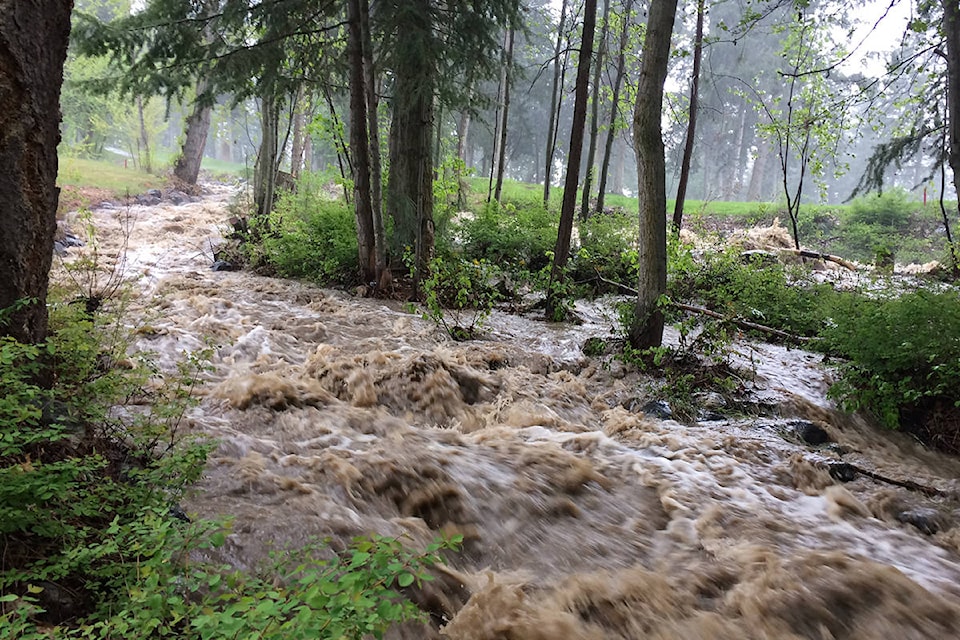Francine Blanchard’s home started to fill with water long before a state of emergency was called in Kelowna.
“Our tenant woke us up at 5 a.m. Friday to say there was water in the basement,” said Blanchard, whose home is on Spencer Road.
As water levels started to rise, Blanchard, who only moved to the area in September, dialed 911, not knowing where to go. Fire crews came out, assessed the situation and she and her husband got to the business of removing some family photos from what they thought would be the flood path.
The neighbourhood, she said, has never flooded since houses were built in 1995 and the creek is far from the property line, so they didn’t expect much.
But the water just kept “rising and rising.”
“Eventually it got too high for our boots, so we started to gather things from upstairs that were important to us,” she said.
By the time the worst of it was over, the basement had five feet of water in it, and Blanchard, her husband and their tenant were forced to leave their home.
Blanchard took to social media immediately, asking if anyone had a furnished suite they could move into and by Sunday she had a new home.
“They didn’t tell us to evacuate by the time I started looking,” she said. “I just knew there was no way I was staying in this house.”
She now knows she won’t be back there for a couple months and the basement suite she rents will be out of commission for around six months.
“It’s taken a toll,” she said. “There’s been some tears and some struggles…but we’re feeling things are getting to a new normal.”
What’s been tough has been that she and her husband are new to the area, so they don’t have the same network of loved ones as they would in Prince George.
The silver lining, however has been watching a new network take shape.
“The strata of Country Roads has been phenomenal,” she said. “People were sandbagging around the clock and coming by and just asking, ‘what can we do?’” she said.
“I feel more a part of this community than I ever have.”
Her husband has also tapped into a strong community, though it’s not necessarily local.
As part of a Clive Cussler book club on Facebook, he’s proudly shared pictures of his collection of hardbacks stacked neatly in his bookshelves.
Those bookshelves, which were in a basement office, have been destroyed.
“He took a picture of them after they were flooded out and now people from all over the world are like ‘where are you? we’re sending you the books,’” she said.
The damage to the property, expands beyond well-loved items, however, and that’s a matter for insurance.
Blanchard, said she’s been lucky so far. Their insurance firm is going to bat for them to get as much coverage as possible, but it won’t be 100 per cent.
“They explained to us that during the floods in High River Alberta, they covered the cost to replacing the drywall and repairs needed up to the bottom of the window seal because that’s a sump-pump failure,” she said.
“The overland water isn’t covered.”
For years flooding assistance was provided by the provincial and federal governments, but flooding insurance is becoming more readily available from privatized companies.
Director of government relations Aaron Sutherland at the Insurance Bureau of Canada said B.C. has been relatively lucky, compared to provinces like Alberta, which had extensive floods in 2013.
“As our climate changes, and as we see more storms happening more often, we can expect flood events to happen more and more frequently,” Sutherland said.
Separate from the standard home owner policy, Sutherland said residential flooding insurance has been available for the past year.
Insurance companies are currently offering residential flooding insurance in B.C. but Sutherland said the government and insurance companies are in a bit of a transition period, with some companies offering it, while the government continues to provide funding.
“Over the next 10 years we expect this market to become increasingly available,” said Sutherland. “We’re in a bit of a transition period right now. Increasingly insurers are taking away that financial burden from government and putting it towards the private sector. Not everyone is going to have it.”
He recommends “people living at risk of (flooding) to get out and find if the protection is available for them.”
For now, government assistance does not cover secondary homes, so if a person owns a home in Vancouver and in the Okanagan, the Okanagan home will not be covered if they aren’t the primary residents, but residential flooding insurance will.
Sutherland estimates it costs roughly $100 to $200 for a majority of Canadian homes per year for flooding insurance.
It varies by company, so he suggests to shop around.
The provincial government is providing disaster financial assurance for homes affected by flooding. “Financial assistance is provided for each accepted claim at 80 per cent of the amount of total eligible damage that exceeds $1,000, to a maximum claim of $300,000,” according to a government release.
http://www.kelownacapnews.com/news/flood-assistance-available/
Going forward will simply require resilience for many Canadians.
Blanchard has seen a good role-model of it close to her water-logged home.
“I will be just be like a dandelion and we’ll get through this,” she said. “They’re already popping through.”
